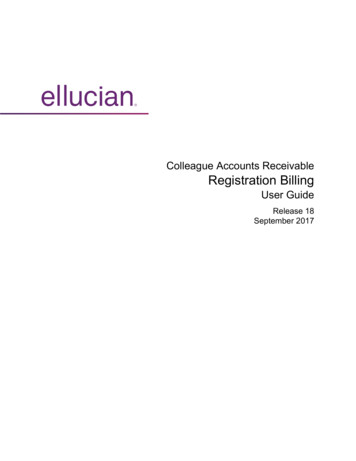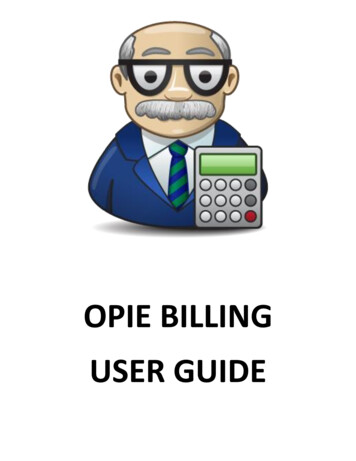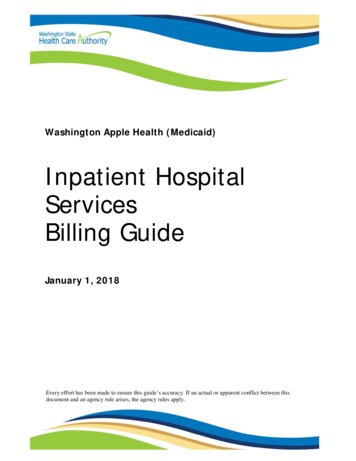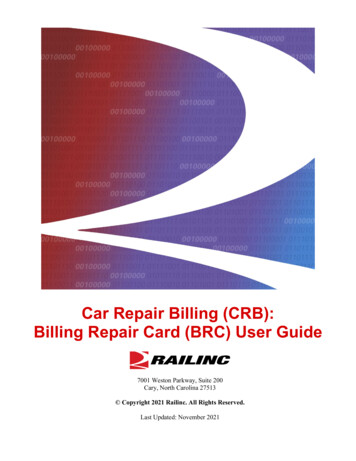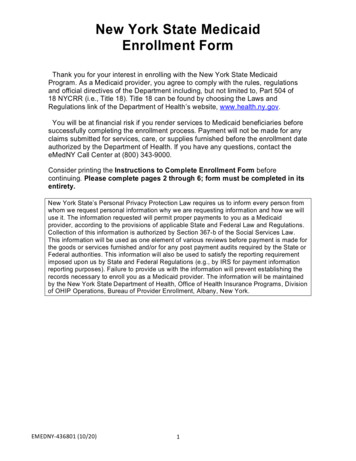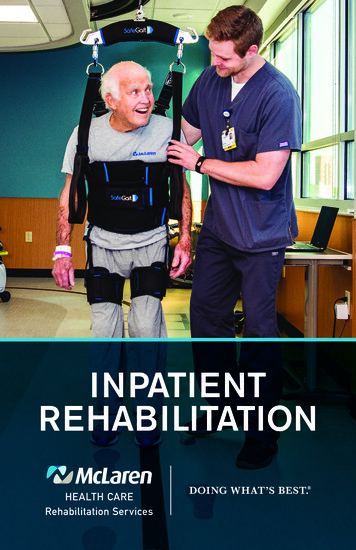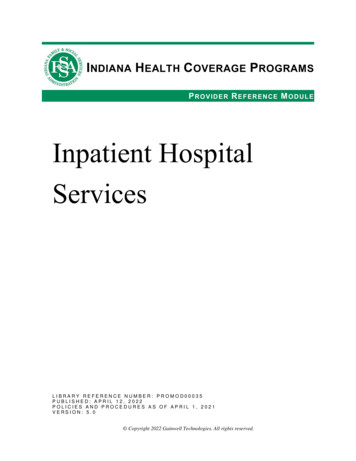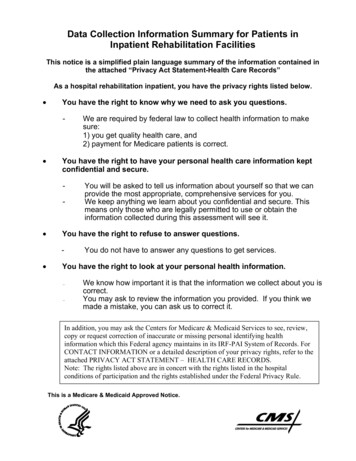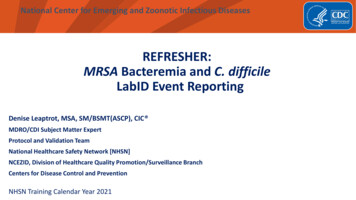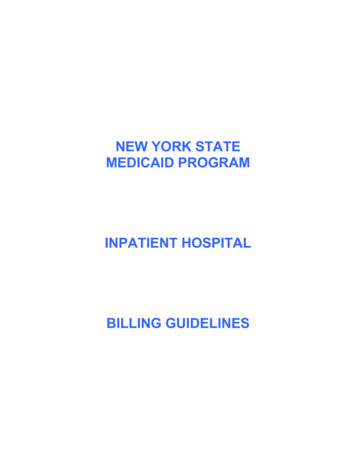
Transcription
NEW YORK STATEMEDICAID PROGRAMINPATIENT HOSPITALBILLING GUIDELINES
Inpatient Hospital Billing GuidelinesTABLE OF CONTENTSSection I – Purpose Statement . 4Section II – Claims Submission Information for All Providers . 5Electronic Claims . 5General Inpatient Billing Procedures . 11Section III – DRG Claims . 14Inpatient Billing Procedures for DRG Claims . 14Non-DRG Claim Procedures . 18Medicaid as Payer of Last Resort . 18Special Instructions for Other Inpatient Claims . 20Medicaid Policy when Medicaid Coverage Begins During an InpatientAdmission . 29Medicare Part A Coverage Begins During Inpatient Admission . 30Section IV – All Patient Refined Diagnosis Related Groups (APRDRG) Claims. 31Inpatient Billing Procedures for APR DRG Claims. 31Special Instructions for Other Inpatient Claims . 34Medicaid Policy when Medicaid Coverage Begins During an InpatientAdmission . 39Medicare Part A Coverage Begins During Inpatient Admission . 39Medicaid as Payer of Last Resort . 40Section V – Supplemental Inpatient Billing Information . 43Inpatient Services Paid "Off-Line". 43Replacement/Void of Previously Paid Claims . 43Medicaid Managed Care Clients. 44Hospital Responsibility for Outside Care: Reimbursement Policy. 44Patient Status Codes . 44Section VI – Remittance Advice . 46Electronic Remittance Advice . 46Paper Remittance Advice . 47Version 2009 – 3 (12/01/09)Page 2 of 88
Inpatient Hospital Billing GuidelinesAppendix A – Edit Information and Explanations . 71Appendix B – Sterilization Consent Form – DSS-3134. 73Appendix C – Acknowledgment of Receipt of HysterectomyInformation Form – DSS-3113 . 80Appendix D – Inpatient Glossary of Terms . 85Version 2009 – 3 (12/01/09)Page 3 of 88
Inpatient Hospital Billing GuidelinesSection I – Purpose StatementThe purpose of this document is to assist the provider community in understanding andcomplying with the New York State Medicaid (NYS Medicaid) requirements andexpectations for: Billing and submitting claims Interpreting and using the information returned in the Medicaid Remittance AdviceThis document is customized for Inpatient Hospital providers and should be used by theprovider as an instructional as well as a reference tool.Inpatient Hospital providers can submit their claims to NYS Medicaid in only anelectronic format. Because there are a variety of different types of inpatient claimingsituations and a variety of electronic billing systems used by providers, the billinginstructions included in this manual are intended to give providers an understanding ofNew York Medicaid’s billing procedures in as much detail as practical.Questions about how this information relates to individual providers’ billing software andsystems should be directed to the appropriate programming or software developmentpersonnel for the hospital or vendor that developed the providers’ billing program.Version 2009 – 3 (12/01/09)Page 4 of 88
Inpatient Hospital Billing GuidelinesSection II – Claims Submission Information for AllProvidersElectronic ClaimsPursuant to the Health Insurance Portability and Accountability Act (HIPAA), Public Law104-191, which was signed into law August 12, 1996, the NYS Medicaid Programadopted the HIPAA-compliant transactions as the sole acceptable format for electronicclaim submission, effective November 2003.Inpatient Hospital providers are required to use the HIPAA 837 Institutional (837I)transaction. In addition to this document, direct billers may also refer to the sourceslisted below to comply with the NYS Medicaid requirements. HIPAA 837I Implementation Guide (IG) explains the proper use of the 837Istandards and program specifications. This document is available atwww.wpc-edi.com/hipaa. NYS Medicaid 837I Companion Guide (CG) is a subset of the IG which providesspecific instructions on the NYS Medicaid requirements for the 837I transaction. 837 Institutional Supplemental CG provides instruction specific to providers whoutilize the 837I transaction. It includes information about various codes setsrelevant to NYS Medicaid Institutional providers. NYS Medicaid Technical Supplementary CG provides technical informationneeded to successfully transmit and receive electronic data. Some of the topicsput forth in this CG are enrollment process, header information, responsedocuments and communication specifications.These documents are available at www.emedny.org by clicking on the link to the webpage below:eMedNY Companion Guides and Sample FilesVersion 2009 – 3 (12/01/09)Page 5 of 88
Inpatient Hospital Billing GuidelinesPre-requirements for the Submission of Electronic ClaimsBefore submitting electronic claims to NYS Medicaid, providers need the following: An Electronic/Paper Transmitter Identification Number (ETIN) A Certification Statement A User ID and Password A Trading Partner Agreement TestingETINThis is a submitter identifier issued by the eMedNY Contractor. All providers arerequired to have an active ETIN on file with the eMedNY Contractor prior to thesubmission of claims. ETINs may be issued to an individual provider or provider group(if they are direct billers) and to service bureaus or clearinghouses.The ETIN application is available at www.emedny.org by clicking on the link to the webpage below:Provider Enrollment FormsCertification StatementAll providers, either direct billers or those who billed through a service bureau orclearinghouse, must file a notarized Certification Statement with NYS Medicaid for eachETIN used for the electronic billing.The Certification Statement is good for one year, after which it needs to be renewed forelectronic billing continuity under a specific ETIN. Failure to renew the CertificationStatement for a specific ETIN will result in claim rejection.The Certification Statement is available on the third page of the ETIN application atwww.emedny.org or can be accessed by clicking on the link above.Version 2009 – 3 (12/01/09)Page 6 of 88
Inpatient Hospital Billing GuidelinesUser ID and PasswordElectronic submitters need a user ID and password to access the NYS MedicaideMedNY system through one of the communication methods available. The user IDand password are issued to the submitter at the time of enrollment in one of thecommunication methods. The method used to apply for a user ID varies depending onthe communication method chosen by the provider. For example: An ePACES user IDis assigned systematically via email while an FTP user ID is assigned after thesubmission of a Security Packet B.Trading Partner AgreementThis document addresses certain requirements applicable to the electronic exchange ofinformation and data associated with health care transactions.The NYS Medicaid Trading Partner Agreement is available at www.emedny.org byclicking on the link to the web page below:Provider Enrollment FormsTestingDirect billers (either individual providers or service bureaus/clearinghouses that bill formultiple providers) are encouraged to submit test transactions to CSC before they startsubmitting Medicaid claims for the first time after enrollment, and any time they updatetheir systems or start using a new system. This testing will assist providers inidentifying errors in their system and allow for corrections before they submit actualclaims.Information and instructions regarding testing are available at www.emedny.org byclicking on the link to the web page below:eMedNY Companion Guides and Sample FilesVersion 2009 – 3 (12/01/09)Page 7 of 88
Inpatient Hospital Billing GuidelinesCommunication MethodsThe following communication methods are available for submission of electronic claimsto NYS Medicaid: ePACES eMedNY eXchange FTP CPU to CPU eMedNY Gateway Simple Object Access Protocol (SOAP)ePACESNYS Medicaid provides a HIPAA-compliant web-based application that is customizedfor specific transactions, including the 837I. ePACES, which is provided free of charge,is ideal for providers with small-to-medium claim volume.The requirements for using ePACES include: An ETIN and Certification Statement should be obtained prior to enrollment Internet Explorer 4.01 and above or Netscape 4.7 and above Internet browser that supports 128-bit encryption and cookies Minimum connection speed of 56K An accessible email addressVersion 2009 – 3 (12/01/09)Page 8 of 88
Inpatient Hospital Billing GuidelinesThe following transactions can be submitted via ePACES: 270/271 - Eligibility Benefit Inquiry and Response 276/277 - Claim Status Request and Response 278 - Prior Approval/Prior Authorization/Service Authorization Request andResponse 837 - Dental, Professional, and Institutional ClaimsTo take advantage of ePACES, providers need to follow an enrollment process.Additional enrollment information is available at www.emedny.org by clicking on the linkto the web page below:Self HelpeMedNY eXchangeeMedNY eXchange is a method in which claims can be submitted and works similarly totypical electronic mail (email). Users are assigned an inbox in the system and are ableto send and receive transaction files. The files are attached to the request and sent toeMedNY for processing. The responses are delivered back to the user’s inbox wherethey can be detached and saved locally. For security reasons, the eMedNYeXchange is accessible only through the eMedNY website at www.emedny.org.Access to the eMedNY eXchange is obtained through an enrollment process. To enrollin eXchange, you must first complete enrollment in ePACES and at least one loginattempt must be successful.FTPFile Transfer Protocol (FTP) is the standard process for batch authorizationtransmissions. FTP allows users to transfer files from their computer to anothercomputer. FTP is strictly a dial-up connection.FTP access is obtained through an enrollment process. To obtain a user name andpassword, you must complete and return a Security Packet B. The Security Packet B isavailable at www.emedny.org by clicking on the link to the web page below:Provider Enrollment FormsVersion 2009 – 3 (12/01/09)Page 9 of 88
Inpatient Hospital Billing GuidelinesCPU to CPUThis method consists of a direct connection established between the submitter and theprocessor and it is most suitable for high volume submitters. For additional informationregarding this access method, contact the eMedNY Call Center at 800-343-9000.eMedNY GatewayThe eMedNY Gateway or Bulletin Board System (BBS) is a dial-up access method thatis only available to existing users. CSC encourages new trading partners to adopt adifferent access method for submissions to NYS Medicaid.(For example: FTP, eMedNYeXchange, SOAP, etc.)Simple Object Access Protocol (SOAP)The Simple Object Access Protocol (SOAP) communication method allows tradingpartners to submit files via the internet under a Service Oriented Architecture (SOA). Itis most suitable for users who prefer to develop an automated, systemic approach to filesubmission.Access to eMedNY via Simple Object Access Protocol must be obtained through anenrollment process that results in the creation of an eMedNY SOAP Certificate and aSOAP Administrator. Minimum requirements for enrollment include: An ETIN and Certification Statement for the enrollee’s Provider ID obtained prior toSOAP enrollment The enrollee must be a Primary ePACES Administrator or The enrollee must have existing FTP access to eMedNYAdditional information about 'Getting Started with SOAP' is available on emedny.org byclicking on the link to the web page below:eMedNY Companion Guides and Sample FilesNotes: For additional information regarding the Simple Object Access Protocol,please send an e-mail to NYHIPAADESK3@csc.com. For questions regarding eXchange, FTP, CPU to CPU or eMedNY Gatewayconnections, call the eMedNY Call Center at 800-343-9000.Version 2009 – 3 (12/01/09)Page 10 of 88
Inpatient Hospital Billing GuidelinesGeneral Inpatient Billing ProceduresThe following information details billing instructions and related information for hospitalinpatient claims in the following main categories: General Inpatient Billing Procedures Reporting Present on Admission (POA) InformationGeneral Inpatient Billing ProceduresWhen calculating the number of days to be reported on a claim, Medicaid counts thedate of admission, but not the date of discharge, transfer or death.The calculation of the number of days in the billing period is impacted by the status ofthe patient on the statement through date. When the patient status is “30” – Still APatient, the through date is included in the calculation of days. When the status is a“Discharged” on the through date of service, the through date is not included in thecalculation of the number of days. See status codes at the end of this section of themanual.The sum of the days reported in the following fields must equal the days in thestatement from-through period of the claim or one less day if the status is discharged asdescribed above: Medicare Full Days Medicaid Full Days Medicaid Non Covered Days and Other Insurance Covered DaysDays billed as covered and non-covered, by the various payers, are reported in the 837Institutional Segments with appropriate qualifiers. The segment and qualifierinformation below may be useful to providers’ programming or software developmentpersonnel.Version 2009 – 3 (12/01/09)Page 11 of 88
Inpatient Hospital Billing GuidelinesType of DaysMedicare Full DaysMedicare Coinsurance DaysMedicare Life Time Reserve DaysMedicaid Full DaysMedicaid Non Covered DaysOther Insurance Covered Days837I Segment NameMIA SegmentQTY SegmentQTY SegmentQTY segmentQTY segmentMIA SegmentQualifierNot ApplicableCDLACANANot ApplicableNotes: Medicare Life Time Reserve (LTR) Days may also be reported in the MIASegment. If LTR days are reported in the MIA Segment, they would overrideany LTR days that may also have been reported in the QTY Segment. The maximum number of days cannot exceed 9999 on any inpatient claim. The two basic types of inpatient hospital claims are Diagnosis-Related Group(DRG) and Non-DRG (DRG-exempt) claims.Reporting Present on Admission (POA) InformationNYSDOH requires this information to be reported for all reported diagnoses on allhospital inpatient claims. Present On Admission is defined as the diagnosis that ispresent at the time the order for inpatient admission occurred. Additional information onreporting this information can be found in the 837I Companion Guide. This document isavailable at www.emedny.org by clicking on the link to the web page below.eMedNY Companion Guides and Sample FilesVersion 2009 – 3 (12/01/09)Page 12 of 88
Inpatient Hospital Billing GuidelinesOne of the following POA Codes must be submitted with the Primary Diagnosis andeach succeeding diagnosis. However, the admitting diagnosis code does not require aPOA. Y – Yes: Present at the time of inpatient admission N – No: Not present at the time of inpatient admission U – Unknown: Documentation is insufficient to determine if condition is present attime of inpatient admission W – Clinically undetermined: Provider is unable to clinically determine whethercondition was present at time of inpatient admission or not 1 – Unreported/Not used: Exempt from POA reportingNote: A blank cannot be used. If a code does not require a POA code then a 1must be entered.Version 2009 – 3 (12/01/09)Page 13 of 88
Inpatient Hospital Billing GuidelinesSection III – DRG ClaimsThis section includes instructions and descriptions for the following: Inpatient Billing Procedures for DRG Claims Non-DRG Claim Procedures Medicaid as Payer of Last Resort Special Instructions for Other Inpatient Claims Medicaid Policy when Medicare Coverage Begins During an Inpatient AdmissionInpatient Billing Procedures for DRG ClaimsThis section details instructions for DRG claims with discharge dates prior toDecember 1, 2009 only. Instructions for claims submitted (including adjustmentsto previously paid claims) with discharge dates on or after December 1, 2009 arelocated in the APR DRG Claims section of this manualDiagnosis-Related Group (DRG) billing classifies inpatient hospital stays into one ofapproximately 800 groups, also referred to as DRGs. A "grouper" program assigns aDRG by utilizing data submitted on the claim such as ICD-9-CM diagnoses, procedures,patient age, sex, and other information.Associated with each DRG is an average length of stay, high trim point (threshold),service intensity weight and low trim point. See definitions that follow:TermHigh TrimLow TrimInlierOutlierShort Stay OutlierCost Per Discharge (CPD)Service Intensity Weight (SIW)Version 2009 – 3 (12/01/09)DefinitionMaximum number of days the patient is expected tobe hospitalized based on the assigned DRGMinimum number of day the patient is expected tobe hospitalized for the assigned DRGPortion of the inpatient stay from the date ofadmission through and including the high trim pointPortion of the inpatient stay from the day after thehigh trim point to date of discharge (also referred toas long stay outlier)Portion of the stay from admission to before the lowtrim pointDollar amount on file for a hospitals DRG rate codeA weighting factor assigned to each DRGPage 14 of 88
Inpatient Hospital Billing GuidelinesTermAverage Length of Stay(ALOS)DefinitionAverage length of a hospital stay for the DRGassignedDRG Rate CodesA claim is classified as a DRG claim based on the submitted rate code. The rate codeis sent in the 837 Institutional Claim in loop 2300, in the Value Information Segment.DRG claims are identified by the following Rate Codes:Type of ClaimNew York State InlierNew York State OutlierOut-of-state InlierOut-of-state OutlierRate Code2946295629532958DRG Payment CalculationsThe following describes the calculations used to price Inpatient DRG claims for NewYork State hospitals by Medicaid.The Inlier claim calculation is as follows:CPD (x) SIW ( ) Capital add on payment amountThe Long Stay Outlier claim calculation is as follows:CPD (x) SIW (x) .275 (x) number of days payment amountALOSThere are two types of Short Stay claims: Non-transfers and Transfers.The Short Stay Non-transfer claim calculation is as follows:CPD (x) SIW ( ) short cap add-on (x) # of days payment amountALOSThe Short Stay Transfer claim calculation is as follows:CPD (x) SIW (x) 1.200% ( ) cap add (x) number of days payment amountALOSVersion 2009 – 3 (12/01/09)Page 15 of 88
Inpatient Hospital Billing GuidelinesSplit-Billing DRG ClaimsRule 1 – Split-BillingDRG claims can be billed from Admission to Discharge and do not have to be split-billedaccording to the high trim point, which is the date that separates Inlier and Outliersegments. The rate code billed would be 2946 or 2953. The eMedNY system willcalculate one payment combining the appropriate payment for the inlier and outlierperiod.DRG claims can also be split-billed at the high trim point for the DRG, i.e., one claim forthe inlier period and a separate claim for the outlier period. In this case, each claim mustbe billed (and will be processed) using the appropriate Inlier and Outlier rate codes.The inlier claim cannot be split at a date that is before the high trim day for the DRGunless the patient is transferred to ALC and continues on ALC on or after the day ofhigh trim. See information on billing procedures for ALC in the section of this manualentitled “Special Instructions for Other Inpatient Claims”.If the DRG claim is split-billed at the high trim point, the inlier claim must containdischarge status code 30 and the discharge date.If the discharge occurs after the high trim point, DRG claims have to be billed, at aminimum, up to the high trim point for the DRG assigned. When billing on separateclaims for the inlier and outlier periods, the high trim day itself is included in the Inlierclaim.Note: There are exceptions to this rule in the “Special Instructions for OtherInpatient Claims” section of this manual under ALC instructions.Rule 2 – Timely Submission of claimsFor DRG claims, the NYS Medicaid 90-day timely submission requirement is based onthe Through Date of Service reported on the claim.Rule 3 – Discharge DateA DRG claim cannot be billed until the patient is discharged. All DRG claims must havethe actual discharge date regardless of the status code of the patient. The dischargedate will not match the end date of service if the patient status is 30 – Still A Patient.Rule 4 - NewbornsDRG claims for newborns, 28 days or younger, must contain the birth weight in grams.Birth weights must be submitted according to the following example:If a client’s birth weight is 2500 grams, the provider must enter the value 250000, toaccount for the decimal.Version 2009 – 3 (12/01/09)Page 16 of 88
Inpatient Hospital Billing GuidelinesRule 5 – Transfers in the Outlier PeriodTransfers in the Outlier period (days after the high trim) are not payable. If the claim isbilled as an Admission to Discharge claim, no payment will be made for outlier days. Ifthe outlier claim is billed separately with patient status code 02 - Discharged/transferredto a short-term general hospital for inpatient care, the claim will be denied for Edit00794, “Outlier Payment Not Allowed for Transfer”.Outlier claims billed with a patient status code 05 - Discharged/transferred to a nonMedicare PPS children's hospital or non-Medicare PPS cancer hospital for inpatientcare, will be paid at 0.00 if the DRG Code assigned is one of the following: 0602through 0630, 0635 or 0641.DRG Admission Day ClaimsProviders have the option of submitting a claim as an Admission Day claim. AdmissionDay claims are submitted to receive some form of payment in lieu of the DRG payment,which cannot be made until the patient is discharged.Admission Day claims must be replaced (adjusted) as a DRG claim within 90 days ofthe payment. If the patient has not been discharged after the 90-day period, the claimshould be submitted as an adjusted Admission day claim. All the data will remain thesame but the adjudication date of the adjustment will cause the 90-day limitation to beextended for another 90 days. If no adjustment is received, the Admission Daypayment will be automatically voided by the system and the admission paymentrecovered.Follow these procedures for submission of Admission Day claims: The rate code billed on the claim is 2960 The Admission date is also submitted as the from and through date of service The patient status code is billed is 30 No discharge date is reported and One day is entered as the Medicaid Covered Days The payment amount for an Admission Day claim is the rate associated with the2960 rate code.Version 2009 – 3 (12/01/09)Page 17 of 88
Inpatient Hospital Billing GuidelinesNon-DRG Claim ProceduresFor non-DRG claims the 90-day regulation applies to the statement through dateentered on the claim.Non-DRG claims can be billed from admission to discharge or they can be billed asinterim claims. If a Non-DRG claim is billed as an interim bill, the patient status codesubmitted is 30 – Still A Patient, and no discharge date is entered on the claim.Medicaid as Payer of Last ResortAll other sources of payments must be exhausted before billing Medicaid. The followingsection of the manual explains billing procedures for patients with other sources ofcoverage. The main topics are as follows: Medicaid Only (No involvement from any other payer) Medicare as Primary – Medicaid as Secondary Other Third party Insurance as Primary – Medicaid as SecondaryMedicaid Only (No involvement from any other payer)The claim can be billed from Admission to Discharge under rate code 2946 regardlessof the high trim. eMedNY will calculate the appropriate payment for both the inlier andoutlier portions of the hospital stay and pay the claim with one payment amount withrate code 2946.The claim can also be submitted on two separate claims for the Inlier and Outlierperiods using the appropriate rate codes.The days are reported as Medicaid Full Covered Days.Medicare as Primary – Medicaid as SecondaryIf Medicare covered the entire stay (and there is no ALC), the only payment due is theDeductible/Coinsurance or Life Term Reserve (LTR) amounts – the claim can be billedfrom Admission to Discharge regardless of the high trim point.All the days are reported as Full-Covered Medicare days.If some or all the days are covered as Coinsurance Days or Life Time Reserved (LTR)Days, then those Coinsurance and/or LTR days are included in the Total CoveredMedicare Days and are repeated in the Coinsurance or LTR day’s fields.Version 2009 – 3 (12/01/09)Page 18 of 88
Inpatient Hospital Billing GuidelinesThe system will pay the reported Part A deductible, which is entered in the CASSegment and the Coinsurance and/or LTR amounts.Note: While the Coinsurance amount is reported in the CAS Segment, there is noLTR amount entered in the CAS Segment. eMedNY will calculate the LTR amountfrom the number of LTR day’s reported on the claim.If Medicare Part A has covered the claim, the Part B patient responsibility can beclaimed. In this instance the Part B payment should not be reported on the claim and,if reported, will be ignored.If Medicare Part A has not covered the claim, Medicare Part B patient responsibilitywill not be paid and the Medicare Part B payment must be reported and deducted fromthe Medicaid payment.Medicare Part ACovered the stayDid not cover the stayPart B Patient ResponsibilityClaim to MedicaidDo not report on claimMedicare Part B PaymentDo not report on claimMust be reported on claimMedicare Exhausts in the Outlier PeriodIf Medicare exhausts in the outlier period, then the inlier claim is billed from the day ofadmission to the last Medicare covered day with patient status code 30 and the actualdischarge date. See the rules for reporting Medicare deductible, Coinsurance and/orLTR above.The period that Medicare did not cover is billed to Medicaid as a separate outlier claim.The outlier claim must contain the appropriate admission date and outlier rate code.The outlier claim must indicate Medicare Full Covered days as zero and zero amountspaid. Additionally, the 0FILL option must be indicated.Medicare Exhausts Before the High Trim PointIf Medicare exhausts before the high trim, then the inlier claim is billed from the day ofadmission to the high trim point. The inlier claim must contain the days Medicarecovered and the remaining days (Medicare non-covered) are reported as Medicaid NonCovered days.A separate claim must be submitted for any days after the high trim point with the outlierrate code.Medicare Coverage Begins After the Admission DateFor billing instructions in this scenario, refer to the Inpatient Policy Guidelines availableat www.emedny.org by clicking on the link below:Inpatient ManualVersion 2009 – 3 (12/01/09)Page 19 of 88
Inpatient Hospital Billing GuidelinesOther Third Party Insurance as Primary – Medicaid as SecondaryThe claim is submitted as a Medicaid Secondary claim. The days covered by the otherinsurance are reported as covered by the insurance and the payment received from theother insurance must be reported on the claim.If another insurance deductible is being claimed it is entered in the CAS Segment of theelectronic claim record. eMedNY will calculate the Medicaid payment and, subtract thereported other Insurance payment, then compare that balance to the deductibleclaimed. eMedNY will pay the lower of the reported deductible or the balance aftersubtracting the other insurance payment from the amount Medicaid would pay.Only bill if there is a patient responsibility, i.e., deductible, coinsurance, copay.Special Instructions for Other Inpatient ClaimsThis section of the manual explains billing requirements for the following types ofclaims: Alternate Level of Care (ALC) Claims Alternate Level of Care - Medicare Non-covered Graduate Medical Expense (GME) Claims Pass Days Claims Cost Outlier ClaimsAlternate Level of Care (ALC)ALC Rule 1 – Patient Cannot Be Admitted Directly to ALC StatusAll patients MUST be admitted as acute care patients. A claim submitted indicating thepatient was admitted on ALC will be denied.ALC Rule 2 – Split-BillingALC claims are Non-DRG (per diem) claims. The ALC claims can be split-billed. Splitbilling
New York Medicaid's billing procedures in as much detail as practical. Questions about how this information relates to individual providers' billing software and systems should be directed to the appropriate programming or software development personnel for the hospital or vendor that developed the providers' billing program.

